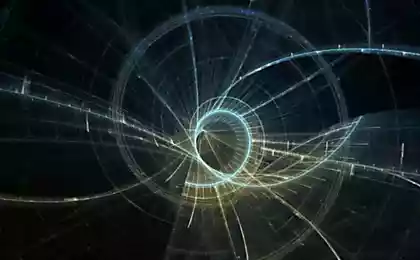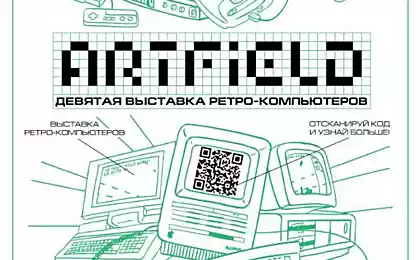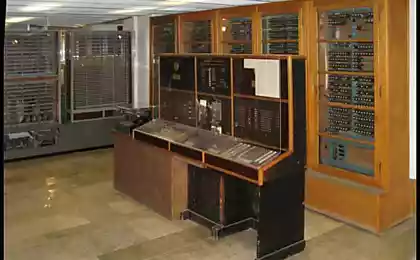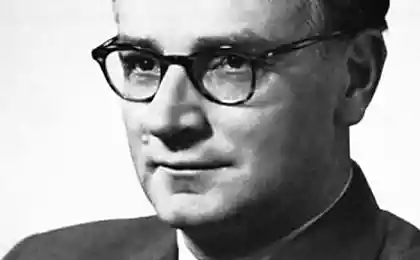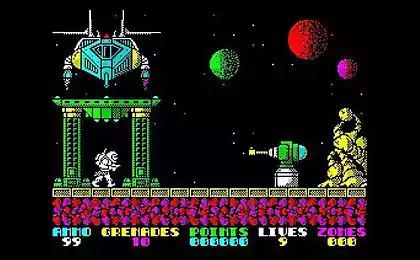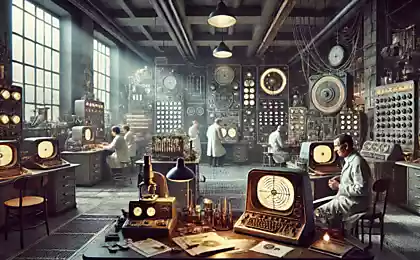1321
The world's first computer
In October day in 1900 a large Greek-mast tartan returning from the African coasts, where a team of 12 people involved in diving for sponges. Tartan Captain Dimitrios Kontos was considered one of the most experienced captains among sponge divers in Greece. The captain knew that the strait between the islands of Crete and Antikythera is one of the worst places like the vessel can catch the storm.
The captain immediately found shelter in Potamos harbor on the northern tip of the island of Antikythera. Port protected by high cliffs of Cape Glifalda. Contos Captain knew that the sailors on the ship were not fools to drink and play cards, so that would prevent booze and fights, he decided to take them diving for sponges, knowing in advance that at this point they should not bylo.Rannim next morning Captain He took the boat to a quiet bay Pinakakiya and the team began their immersion suits in diving to a depth of 45 meters at intervals of 5 minutes. Such was the depth limit for divers of vremeni.Shest divers plunged into the water for 30 minutes, and the rest is sitting at the oars, and shook the air pump.
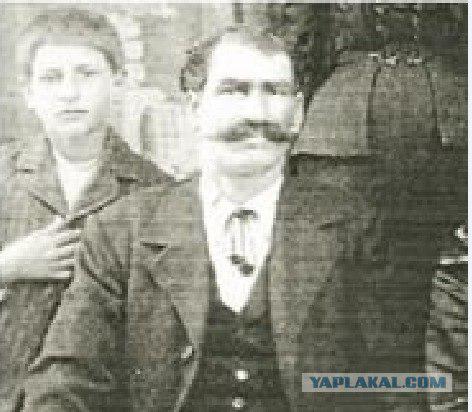
First assistant captain and most experienced diver Elias Statiatis not prov under water even half allotted vremeni.On suddenly pulled the cord, giving the sign of an immediate recovery. On board the ship, he got out with bulging eyes and unusually blednyy.On started mumbling something incoherent about naked women in flowing dresses, horses and something about the Virgin Mary. Since, despite the shouts Captain Elias has not recovered, the captain, experienced diver himself without hesitation put on a diving suit and plunged into the water.
After staying under water only a few minutes the captain came back beaming with joy bort.Kogda team pulled out of the water his cart, their eyes appeared a piece of metal hand-statue. At the bottom lay a Roman galley full of stones and bronze statues that elderly Elias took for mermaids. At the bottom lay the whole treasure of the precious metal and several tons of lead-blocks, which the Romans used to weight anchors. Captain Contos sold some of the finds, the rest like a true Greek patriots passed to the state. Greek authorities immediately interested finds and driven to the place of the shipwreck a few cranes. Soon, the most valuable was podnyatno to the surface, and the captain at the time of Contos became a rich man, even ordered a new ship. He then smuggled French rifles across the Mediterranean, engaged in big business, but soon went bankrupt. After all the failures of his vehicle was taken away for debts, and he returned to diving for gubkami.V speed in the water of his paralysis, and he died in the house of his daughter, his adopted at Suez, Egypt, leaving a penny.
However, among the finds at the bottom near the island of Antikythera was one very primechatelnaya thing.
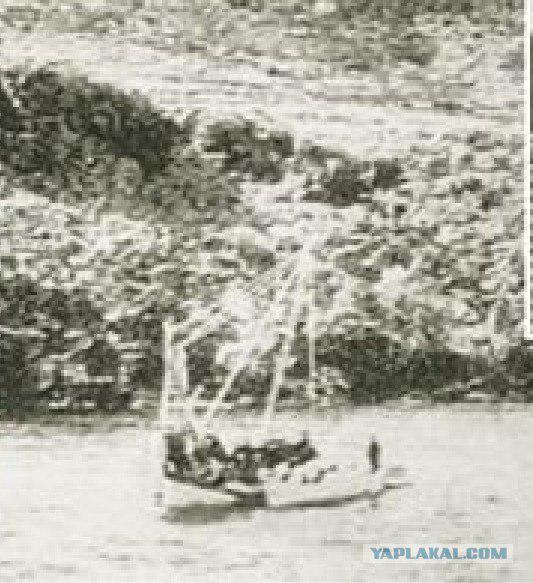
The following year, Greek archaeologists by divers began exploring the sunken ship, which turned out to be a Roman cargo ship crashed about 80-50 years. BC. From the bottom of the sea had been raised numerous artefacts: bronze and marble statues, amphorae, etc. Among the works of art found - two masterpieces exhibited in the National Archaeological Museum in Athens: a bronze statue of "Boys of Antikythera" (around 340 BC) and the so-called "The head of the philosopher».
According to the most probable hypothesis, the ship went to the island of Rhodes, probably in Rome with the spoils of a diplomatic "gifts." As is known, the conquest of Greece by Rome was accompanied by the systematic removal of "cultural values" in Italy.
Among the items raised from the sunken ship proved to be a shapeless lump corroded bronze, covered with limestone deposits received for the first fragment of the statue. In 1902 he took up the study of the archaeologist Valerios Stais. After clearing it from the lime, he, to his surprise, found a complex mechanism such as time, with a lot of bronze gears, drive shafts and remains of the measuring scales. Also parse some inscriptions in ancient Greek.
After lying 2,000 years on the seabed, the mechanism has reached us in a very damaged state. The wooden frame on which he apparently fastened completely disintegrated. Metal parts are severely deformed and corroded. In addition, many pieces of machinery were lost.
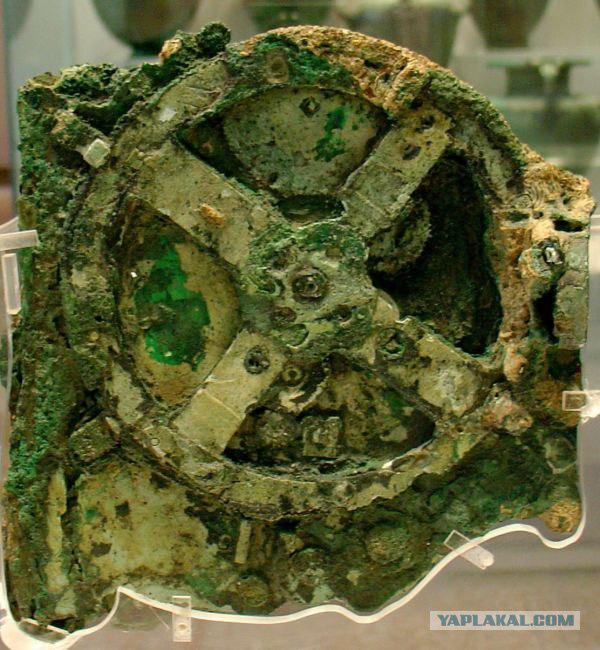
In 1903 in Athens, it came the first official scientific publication with a description and photographs Antikythera Mechanism, as it was called this device.
It took hard work on clearing device, which lasted more than a decade. His reconstruction of the affair seemed almost hopeless, and it long remained little known until it attracted the attention of the English physicist and science historian Derek de Solla Price (Derek J. de Solla Price). In 1959, the magazine «Scientific American» published an article Price "Ancient Greek computer" dedicated to Antikythera Mechanism, which became a milestone in his issledovanii.1
Price suggested that the Antikythera mechanism was created around 85-80 BC However, radiocarbon analysis (1971) and epigraphic study of inscriptions pushed their estimated time of its creation until 150-100 years. BC
In 1971, Price, then a professor of history of science at Yale University, in conjunction with Karakalosom Charalampos, Professor of Nuclear Physics of the Greek National Center for Scientific Research "Democritus" Antikythera Mechanism conducted a study using X-ray and gamma radiography, which gave valuable information on the internal configuration of the device.
In 1974, in the article "Greek gear - computer calendar BC" 2 Price presented a theoretical model Antikythera Mechanism, based on which, the Australian scientist Allan George Bromley of the University of Sydney and watchmaker Frank Percival produced the first working model. A few years later, the British inventor John Gliv engaged in manufacturing planetarium, constructed a more detailed pattern, working under the scheme Pryce.
In 1978, the famous French explorer Jacques-Yves Cousteau once again examined the place of discovery, but found more remains of the Antikythera Mechanism.
Great contribution to the study of the Antikythera Mechanism, introduced Michael Wright, a member of the London Science Museum and Imperial College London, used to study the method of linear fragments of the original X-ray tomography. The first results of this study were presented in 1997, which significantly correct conclusions Pryce.
In 2005, he started an international project «Antikythera Mechanism Research Project» with the participation of scientists from the UK, Greece and the United States under the auspices of the Ministry of Culture of Greece. Also in 2005, it was announced the discovery of the new mechanism fragments. Using the latest technology (computed tomography) has allowed 95% read the inscriptions on the mechanism (about 2000 characters). The results are set out in an article published in the journal «Nature» (11/2006) 3.
Continue its research and Michael Wright, who introduced in 2007 modified model Antikythera Mechanism.
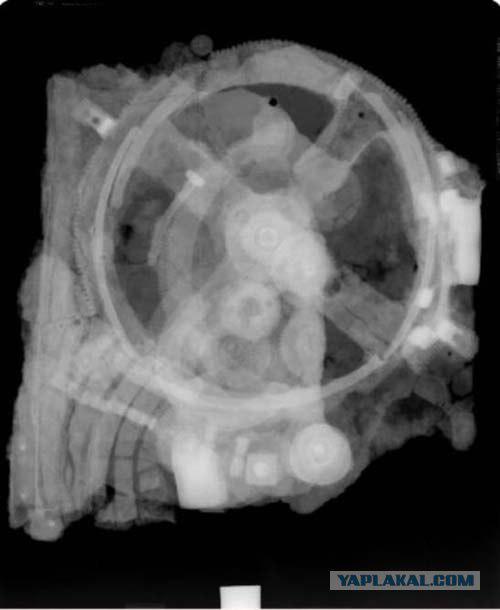
Together, the researchers gradually Antikythera mechanism reveals its secrets, expanding our understanding of the possibilities of ancient science and technology.
All metal parts are preserved Antikythera Mechanism made of bronze sheet thickness of 1-2 mm. Many of the fragments are almost completely transformed into products of corrosion, but in many places it is still possible to discern the elegant details of the mechanism.
It is now known 7 large (AG) and 75 small fragments of Antikythera Mechanism.
Photo 1. The Antikythera mechanism, fragments AG. Radiography. Scale is not met
Most of the remaining parts of the internal mechanism - residues twenty seven small diameter gear of 9 to 130 millimeters, placed in a complex sequence of twelve individual axes, placed inside the large fragment mechanism (fragment A, Picture 2, 3). The size of this part is 217 millimeters. Most wheels carries his was to the shafts, which rotate in a hole made in the plate housing. Line outlines what was left of the body (one face and a rectangular joint), which suggests that he was right. Concentric arc well on x-ray, are part of the lower dial back. Remains of wooden slats, presumably one of the two separating face of the housing located between near edge frame preserved. One can distinguish the traces of two wooden pieces at a distance from the side and rear face frame body which are closed in the corner joint with a beveled corner.
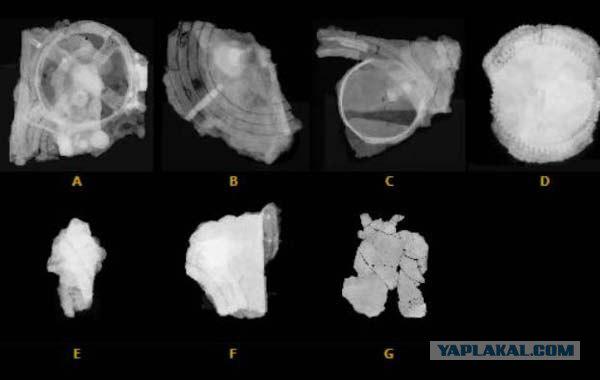
Most of the remaining parts of the internal mechanism - residues twenty seven small diameter gear of 9 to 130 millimeters, placed in a complex sequence of twelve individual axes, placed inside the large fragment mechanism (fragment A, Picture 2, 3). The size of this part is 217 millimeters. Most wheels carries his was to the shafts, which rotate in a hole made in the plate housing. Line outlines what was left of the body (one face and a rectangular joint), which suggests that he was right. Concentric arc well on x-ray, are part of the lower dial back. Remains of wooden slats, presumably one of the two separating face of the housing located between near edge frame preserved. One can distinguish the traces of two wooden pieces at a distance from the side and rear face frame body which are closed in the corner joint with a beveled corner.
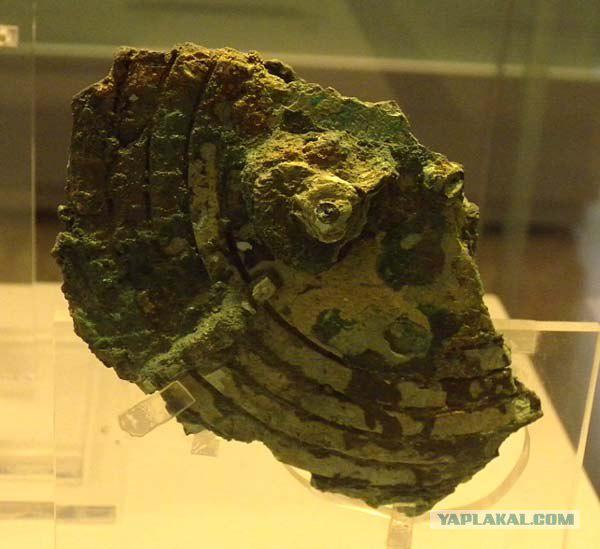
Fragment B, measuring about 124 millimeters (4 photos) consists mainly of the remainder of the back of the top of the dial with two broken shafts and traces of another gear. Fragments A and B adjacent to each other, while the fragment E, of about 64 millimeters, which is a smaller part of the dial, placed therebetween. Put together, they allow us to consider the device back panel consisting of two large dials having a spiral form of four or five concentric converging rings arranged one above the other on a rectangular plate, whose height is approximately twice the width. In a recently discovered fragment F is also a piece of the rear dial with traces of wooden parts forming joint in the corner of the plate.
The size of the fragment C is about 120 millimeters (photo 5). The largest single part of the fragment - the opposite corner of the dial (front) side, which forms the main "screen". The dial consists of two concentric scales with divisions. One of them, carved directly into the plate on the outside of the large round holes, was divided into 360 divisions that make up the twelve groups of thirty divisions with names of the zodiac signs. The second scale is broken into 365 divisions (days), as was a group of thirty divisions with names of months, according to the Egyptian calendar. Near the corner of the dial placed a small valve, which is actuated by a trigger lever. It served to keep the dial. On the reverse side of the fragment, tightly bonded thereto corrosion products, it is concentric item containing the remains of tiny gear is part of the device to display information about the phases of the moon.
In all of these fragments can be distinguished traces of bronze plates, placed over the dials. They were densely filled with inscriptions. Some of the pieces were removed from the surface of the main parts in the process of purification and storage, while others again gathered in what is now known as a fragment G. It remains fragmented parts, mostly tiny pieces assigned a number.
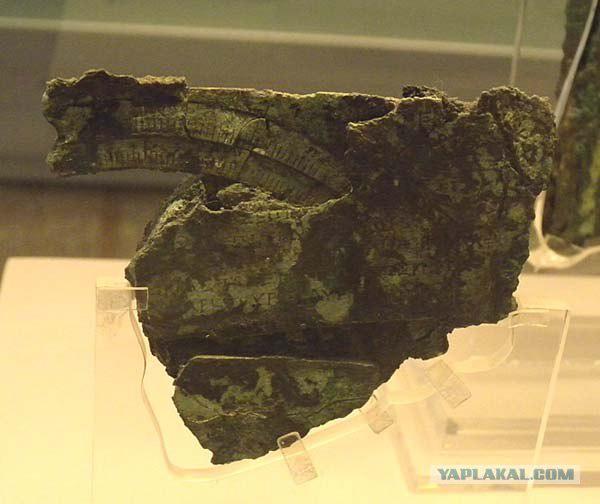
Fragment D consists of two wheels, aligned with each other by means of a thin flat plate laid between them. These wheels are not completely circular shape, the shaft on which they must be positioned offline. For them there is no place for other extant fragments and thus, their appointment can not be established.
All fragments of Antikythera Mechanism is stored in the National Archaeological Museum in Athens. Fragments A, B and C are shown in the museum.
Appointment and functions
Even at the initial stage of the study, due to the surviving inscriptions and scales Antikythera mechanism has been identified as a certain device for astronomical purposes. According to the first hypothesis, it was some kind of navigation tool might astrolabe (a sort of circular star chart with means for determining the coordinates of stars and other astronomical observations). The inventor of the astrolabe is considered the ancient Greek astronomer Hipparchus (c. 180-190 - 125 BC). However, it soon became clear that this is a much more complex device.
In terms of miniaturization and complexity of the Antikythera mechanism is comparable with the astronomical clock of the XVIII century. It contains more than 30 gears with teeth in the form of equilateral triangles. Such a high complexity and flawless manufacturing suggest that he had a number of predecessors that have not been found.
According to the second hypothesis, the Antikythera mechanism was a "flat" version mechanical celestial globe (planetarium), created by Archimedes (c. 287 - 212 BC), reported by ancient authors.
The earliest mention of a globe of Archimedes refers to I in. BC. The dialogue of the famous Roman orator Cicero's "On state" conversation between participants conversation comes to solar eclipses, and one of them says: "I remember how I once together with Guy Sulpicius Gallus, one of the most learned men of our country ... was visiting Marcus Marcellus ... and Gall asked him to bring the famous "sphere", the only trophy that the great-grandfather of Marcellus wished to decorate his house after taking Syracuse, a city full of treasures and miracles. I have often heard tell of this "field", which is considered a masterpiece of Archimedes, and I must admit that at first I did not find it anything special. More beautiful and more famous among the people was another area, created by the same Archimedes, which is the same Marcellus gave the temple of Valor. But when Gall began with great skill to explain to us the device of this device, I have come to the conclusion that the Sicilian had a talent greater than what a person may have. For Gull said that ... a solid sphere without voids was invented a long time ... but, - said Gall - such scope, which would be represented by the movement of the sun, moon and five stars ... called wandering, could not be established in the form of a solid body; Archimedes amazing invention by the fact that he invented, how, with disparate movements during one revolution to maintain unequal and different ways. When Gall led this area to move happened so that this ball of bronze alternated with the moon the sun for as many revolutions, in how many days it is replaced it at the sky, so that the scope and the sky was going the same eclipse of the sun, and the moon He entered into the same Meta, where the shadow of the earth, the sun from the field ... [Gap] "(Cicero. On the state, I, 14.)
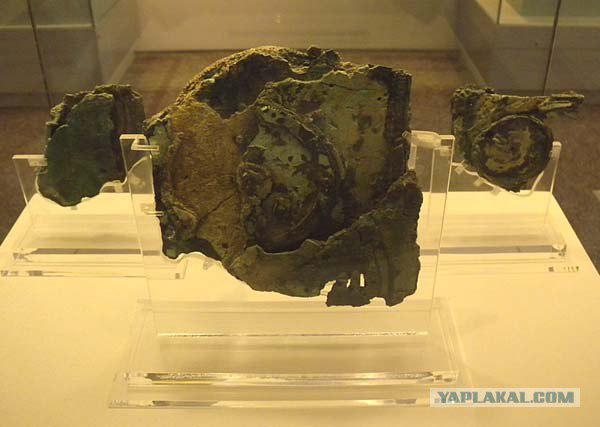
On the internal mechanism of the celestial globe of Archimedes significantly is not known. It can be assumed that it consisted of a complex system of gears as Antikythera Mechanism. Archimedes wrote a book about the structure of the celestial globe ("On the production areas"), but, unfortunately, it has been lost.
Cicero also writes about other similar devices made by Posidonius (c. 135 - 51 BC), Stoic philosopher and scientist who lived on the island of Rhodes, where, perhaps, sailed the ship carrying the Antikythera Mechanism, "If someone some brought to Scythia or Britain the ball (sphaera), recently produced our friend Posidonius, ball, individual turnovers that reproduces what happens in the sky with the sun, moon and five planets on different days and nights, then who in these barbarous countries doubt, be that the ball - the product of a perfect understanding? "(Cicero. On the Nature of the Gods, II, 34.)
Thus, the existence of the ancient mechanisms comparable in complexity to Antikythera, is confirmed by ancient authors, although none of them has come down to us.
BC.
Source:
The captain immediately found shelter in Potamos harbor on the northern tip of the island of Antikythera. Port protected by high cliffs of Cape Glifalda. Contos Captain knew that the sailors on the ship were not fools to drink and play cards, so that would prevent booze and fights, he decided to take them diving for sponges, knowing in advance that at this point they should not bylo.Rannim next morning Captain He took the boat to a quiet bay Pinakakiya and the team began their immersion suits in diving to a depth of 45 meters at intervals of 5 minutes. Such was the depth limit for divers of vremeni.Shest divers plunged into the water for 30 minutes, and the rest is sitting at the oars, and shook the air pump.

First assistant captain and most experienced diver Elias Statiatis not prov under water even half allotted vremeni.On suddenly pulled the cord, giving the sign of an immediate recovery. On board the ship, he got out with bulging eyes and unusually blednyy.On started mumbling something incoherent about naked women in flowing dresses, horses and something about the Virgin Mary. Since, despite the shouts Captain Elias has not recovered, the captain, experienced diver himself without hesitation put on a diving suit and plunged into the water.
After staying under water only a few minutes the captain came back beaming with joy bort.Kogda team pulled out of the water his cart, their eyes appeared a piece of metal hand-statue. At the bottom lay a Roman galley full of stones and bronze statues that elderly Elias took for mermaids. At the bottom lay the whole treasure of the precious metal and several tons of lead-blocks, which the Romans used to weight anchors. Captain Contos sold some of the finds, the rest like a true Greek patriots passed to the state. Greek authorities immediately interested finds and driven to the place of the shipwreck a few cranes. Soon, the most valuable was podnyatno to the surface, and the captain at the time of Contos became a rich man, even ordered a new ship. He then smuggled French rifles across the Mediterranean, engaged in big business, but soon went bankrupt. After all the failures of his vehicle was taken away for debts, and he returned to diving for gubkami.V speed in the water of his paralysis, and he died in the house of his daughter, his adopted at Suez, Egypt, leaving a penny.
However, among the finds at the bottom near the island of Antikythera was one very primechatelnaya thing.

The following year, Greek archaeologists by divers began exploring the sunken ship, which turned out to be a Roman cargo ship crashed about 80-50 years. BC. From the bottom of the sea had been raised numerous artefacts: bronze and marble statues, amphorae, etc. Among the works of art found - two masterpieces exhibited in the National Archaeological Museum in Athens: a bronze statue of "Boys of Antikythera" (around 340 BC) and the so-called "The head of the philosopher».
According to the most probable hypothesis, the ship went to the island of Rhodes, probably in Rome with the spoils of a diplomatic "gifts." As is known, the conquest of Greece by Rome was accompanied by the systematic removal of "cultural values" in Italy.
Among the items raised from the sunken ship proved to be a shapeless lump corroded bronze, covered with limestone deposits received for the first fragment of the statue. In 1902 he took up the study of the archaeologist Valerios Stais. After clearing it from the lime, he, to his surprise, found a complex mechanism such as time, with a lot of bronze gears, drive shafts and remains of the measuring scales. Also parse some inscriptions in ancient Greek.
After lying 2,000 years on the seabed, the mechanism has reached us in a very damaged state. The wooden frame on which he apparently fastened completely disintegrated. Metal parts are severely deformed and corroded. In addition, many pieces of machinery were lost.

In 1903 in Athens, it came the first official scientific publication with a description and photographs Antikythera Mechanism, as it was called this device.
It took hard work on clearing device, which lasted more than a decade. His reconstruction of the affair seemed almost hopeless, and it long remained little known until it attracted the attention of the English physicist and science historian Derek de Solla Price (Derek J. de Solla Price). In 1959, the magazine «Scientific American» published an article Price "Ancient Greek computer" dedicated to Antikythera Mechanism, which became a milestone in his issledovanii.1
Price suggested that the Antikythera mechanism was created around 85-80 BC However, radiocarbon analysis (1971) and epigraphic study of inscriptions pushed their estimated time of its creation until 150-100 years. BC
In 1971, Price, then a professor of history of science at Yale University, in conjunction with Karakalosom Charalampos, Professor of Nuclear Physics of the Greek National Center for Scientific Research "Democritus" Antikythera Mechanism conducted a study using X-ray and gamma radiography, which gave valuable information on the internal configuration of the device.
In 1974, in the article "Greek gear - computer calendar BC" 2 Price presented a theoretical model Antikythera Mechanism, based on which, the Australian scientist Allan George Bromley of the University of Sydney and watchmaker Frank Percival produced the first working model. A few years later, the British inventor John Gliv engaged in manufacturing planetarium, constructed a more detailed pattern, working under the scheme Pryce.
In 1978, the famous French explorer Jacques-Yves Cousteau once again examined the place of discovery, but found more remains of the Antikythera Mechanism.
Great contribution to the study of the Antikythera Mechanism, introduced Michael Wright, a member of the London Science Museum and Imperial College London, used to study the method of linear fragments of the original X-ray tomography. The first results of this study were presented in 1997, which significantly correct conclusions Pryce.
In 2005, he started an international project «Antikythera Mechanism Research Project» with the participation of scientists from the UK, Greece and the United States under the auspices of the Ministry of Culture of Greece. Also in 2005, it was announced the discovery of the new mechanism fragments. Using the latest technology (computed tomography) has allowed 95% read the inscriptions on the mechanism (about 2000 characters). The results are set out in an article published in the journal «Nature» (11/2006) 3.
Continue its research and Michael Wright, who introduced in 2007 modified model Antikythera Mechanism.

Together, the researchers gradually Antikythera mechanism reveals its secrets, expanding our understanding of the possibilities of ancient science and technology.
All metal parts are preserved Antikythera Mechanism made of bronze sheet thickness of 1-2 mm. Many of the fragments are almost completely transformed into products of corrosion, but in many places it is still possible to discern the elegant details of the mechanism.
It is now known 7 large (AG) and 75 small fragments of Antikythera Mechanism.
Photo 1. The Antikythera mechanism, fragments AG. Radiography. Scale is not met
Most of the remaining parts of the internal mechanism - residues twenty seven small diameter gear of 9 to 130 millimeters, placed in a complex sequence of twelve individual axes, placed inside the large fragment mechanism (fragment A, Picture 2, 3). The size of this part is 217 millimeters. Most wheels carries his was to the shafts, which rotate in a hole made in the plate housing. Line outlines what was left of the body (one face and a rectangular joint), which suggests that he was right. Concentric arc well on x-ray, are part of the lower dial back. Remains of wooden slats, presumably one of the two separating face of the housing located between near edge frame preserved. One can distinguish the traces of two wooden pieces at a distance from the side and rear face frame body which are closed in the corner joint with a beveled corner.

Most of the remaining parts of the internal mechanism - residues twenty seven small diameter gear of 9 to 130 millimeters, placed in a complex sequence of twelve individual axes, placed inside the large fragment mechanism (fragment A, Picture 2, 3). The size of this part is 217 millimeters. Most wheels carries his was to the shafts, which rotate in a hole made in the plate housing. Line outlines what was left of the body (one face and a rectangular joint), which suggests that he was right. Concentric arc well on x-ray, are part of the lower dial back. Remains of wooden slats, presumably one of the two separating face of the housing located between near edge frame preserved. One can distinguish the traces of two wooden pieces at a distance from the side and rear face frame body which are closed in the corner joint with a beveled corner.

Fragment B, measuring about 124 millimeters (4 photos) consists mainly of the remainder of the back of the top of the dial with two broken shafts and traces of another gear. Fragments A and B adjacent to each other, while the fragment E, of about 64 millimeters, which is a smaller part of the dial, placed therebetween. Put together, they allow us to consider the device back panel consisting of two large dials having a spiral form of four or five concentric converging rings arranged one above the other on a rectangular plate, whose height is approximately twice the width. In a recently discovered fragment F is also a piece of the rear dial with traces of wooden parts forming joint in the corner of the plate.
The size of the fragment C is about 120 millimeters (photo 5). The largest single part of the fragment - the opposite corner of the dial (front) side, which forms the main "screen". The dial consists of two concentric scales with divisions. One of them, carved directly into the plate on the outside of the large round holes, was divided into 360 divisions that make up the twelve groups of thirty divisions with names of the zodiac signs. The second scale is broken into 365 divisions (days), as was a group of thirty divisions with names of months, according to the Egyptian calendar. Near the corner of the dial placed a small valve, which is actuated by a trigger lever. It served to keep the dial. On the reverse side of the fragment, tightly bonded thereto corrosion products, it is concentric item containing the remains of tiny gear is part of the device to display information about the phases of the moon.
In all of these fragments can be distinguished traces of bronze plates, placed over the dials. They were densely filled with inscriptions. Some of the pieces were removed from the surface of the main parts in the process of purification and storage, while others again gathered in what is now known as a fragment G. It remains fragmented parts, mostly tiny pieces assigned a number.

Fragment D consists of two wheels, aligned with each other by means of a thin flat plate laid between them. These wheels are not completely circular shape, the shaft on which they must be positioned offline. For them there is no place for other extant fragments and thus, their appointment can not be established.
All fragments of Antikythera Mechanism is stored in the National Archaeological Museum in Athens. Fragments A, B and C are shown in the museum.
Appointment and functions
Even at the initial stage of the study, due to the surviving inscriptions and scales Antikythera mechanism has been identified as a certain device for astronomical purposes. According to the first hypothesis, it was some kind of navigation tool might astrolabe (a sort of circular star chart with means for determining the coordinates of stars and other astronomical observations). The inventor of the astrolabe is considered the ancient Greek astronomer Hipparchus (c. 180-190 - 125 BC). However, it soon became clear that this is a much more complex device.
In terms of miniaturization and complexity of the Antikythera mechanism is comparable with the astronomical clock of the XVIII century. It contains more than 30 gears with teeth in the form of equilateral triangles. Such a high complexity and flawless manufacturing suggest that he had a number of predecessors that have not been found.
According to the second hypothesis, the Antikythera mechanism was a "flat" version mechanical celestial globe (planetarium), created by Archimedes (c. 287 - 212 BC), reported by ancient authors.
The earliest mention of a globe of Archimedes refers to I in. BC. The dialogue of the famous Roman orator Cicero's "On state" conversation between participants conversation comes to solar eclipses, and one of them says: "I remember how I once together with Guy Sulpicius Gallus, one of the most learned men of our country ... was visiting Marcus Marcellus ... and Gall asked him to bring the famous "sphere", the only trophy that the great-grandfather of Marcellus wished to decorate his house after taking Syracuse, a city full of treasures and miracles. I have often heard tell of this "field", which is considered a masterpiece of Archimedes, and I must admit that at first I did not find it anything special. More beautiful and more famous among the people was another area, created by the same Archimedes, which is the same Marcellus gave the temple of Valor. But when Gall began with great skill to explain to us the device of this device, I have come to the conclusion that the Sicilian had a talent greater than what a person may have. For Gull said that ... a solid sphere without voids was invented a long time ... but, - said Gall - such scope, which would be represented by the movement of the sun, moon and five stars ... called wandering, could not be established in the form of a solid body; Archimedes amazing invention by the fact that he invented, how, with disparate movements during one revolution to maintain unequal and different ways. When Gall led this area to move happened so that this ball of bronze alternated with the moon the sun for as many revolutions, in how many days it is replaced it at the sky, so that the scope and the sky was going the same eclipse of the sun, and the moon He entered into the same Meta, where the shadow of the earth, the sun from the field ... [Gap] "(Cicero. On the state, I, 14.)

On the internal mechanism of the celestial globe of Archimedes significantly is not known. It can be assumed that it consisted of a complex system of gears as Antikythera Mechanism. Archimedes wrote a book about the structure of the celestial globe ("On the production areas"), but, unfortunately, it has been lost.
Cicero also writes about other similar devices made by Posidonius (c. 135 - 51 BC), Stoic philosopher and scientist who lived on the island of Rhodes, where, perhaps, sailed the ship carrying the Antikythera Mechanism, "If someone some brought to Scythia or Britain the ball (sphaera), recently produced our friend Posidonius, ball, individual turnovers that reproduces what happens in the sky with the sun, moon and five planets on different days and nights, then who in these barbarous countries doubt, be that the ball - the product of a perfect understanding? "(Cicero. On the Nature of the Gods, II, 34.)
Thus, the existence of the ancient mechanisms comparable in complexity to Antikythera, is confirmed by ancient authors, although none of them has come down to us.
BC.
Source:



